Writesonic AI Humanizer Review: Free, But Is It Effective?

If you're looking to humanize AI-generated text, you've probably come across tools like Writesonic.
But how well does it actually work?
In this review, we’ll dive into its effectiveness and whether it truly helps make your content sound more natural.
Stick around to see if it’s the right fit for your needs—or if there’s a better alternative out there.
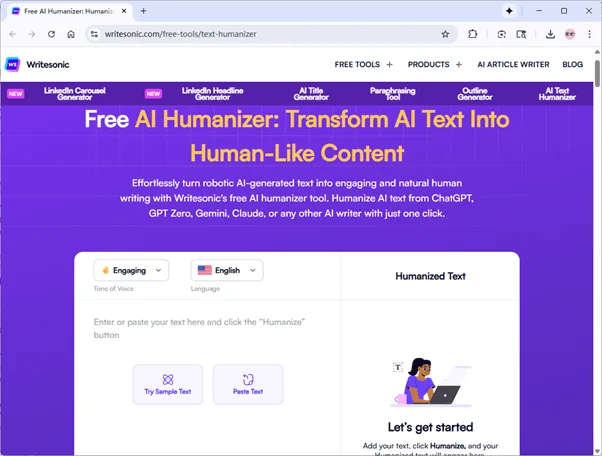
What Is Writesonic?
Writesonic is an AI-powered writing tool designed to assist with content creation, from marketing copy to articles and SEO optimization.
What Is Writesonic AI Humanizer?
One of the features of Writesonic is its AI Humanizer. This tool aims to transform AI-generated content into more natural, human-like text. According to its claims, it can bypass AI detection tools such as GPT Zero. It allows users to select different writing tones—whether engaging, persuasive, or conversational.
Why Do We Do This Test?
Simple. We want to see if Writesonic AI Humanizer actually does what it says.
Does it turn robotic AI text into something that sounds more natural and human? And, maybe more importantly, can it fool those AI detection tools that are always popping up in both academia and content creation?
We’ll dive into these questions and see if the tool really delivers on its promises.
Testing Writesonic AI Humanizer
Methodology Explanation
Here’s how we’re going to test Writesonic AI Humanizer:
We start by using ChatGPT to create 100% AI-generated text.
Next, we’ll run that text through Writesonic AI Humanizer to see how well it changes the tone and feel.
To check its effectiveness, we’ll run the humanized text through five of the top AI detection tools to get the AI score.
We’ll also take a look at the writing quality using Grammarly and fix any grammar issues.
Finally, we’ll test the revised version again to see if the AI score changes, which will help us figure out whether the humanizer intentionally introduces any grammar issues to throw off AI detectors.
Testing Text
Topic: The Influence of Online Shopping on Consumer Behavior in Generation Z
Words: 186
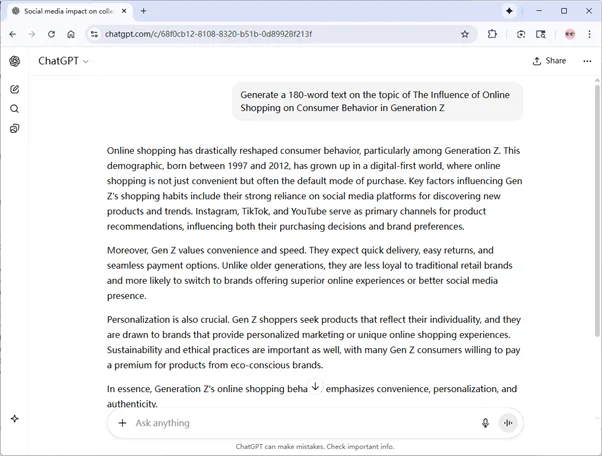
Humanized by Writesonic AI Humanizer
Now, let’s see the text after being humanized using the academic mode.
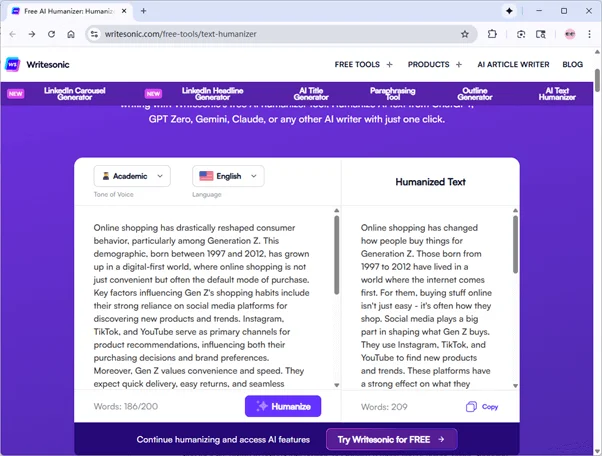
Test Results: How Well Did Writesonic Perform?
We ran the text through Writesonic AI Humanizer and checked the results with five AI detection tools. Here are the scores showing how well the humanizer worked:
AI Score After Writesonic AI Humanizer Humanized
Detector | AI Score After Humanization |
|---|---|
QuillBot | 39% AI |
Originality.ai | 100% AI |
ZeroGPT | 100% AI |
GPTzero | 100% AI |
Writer | 5% AI |
Results Breakdown
So, what do these scores really mean?
Well, with tools like Writer, the AI score is pretty low, meaning Writesonic humanizer did a solid job of making the content sound more like it was written by a person.
But when we look at detectors like Originality.ai, ZeroGPT, and GPTzero, they still flagged the text as mostly AI-generated.
In short, while the humanizer definitely helps make the text more readable and engaging, it’s not perfect. It works pretty well in some cases, but it doesn’t always fool the more sensitive AI detection tools.
How Good Is the Quality of Writesonic Humanized Text?
We took a closer look at the quality of the text after it was humanized by Writesonic AI Humanizer, and here’s what we found.
Overall Score, Grammar & Quality
The text scored 90 out of 100 in Grammarly, indicating that the quality of the content was quite solid, though there was room for improvement. It had a few grammatical suggestions, but nothing major stood out.
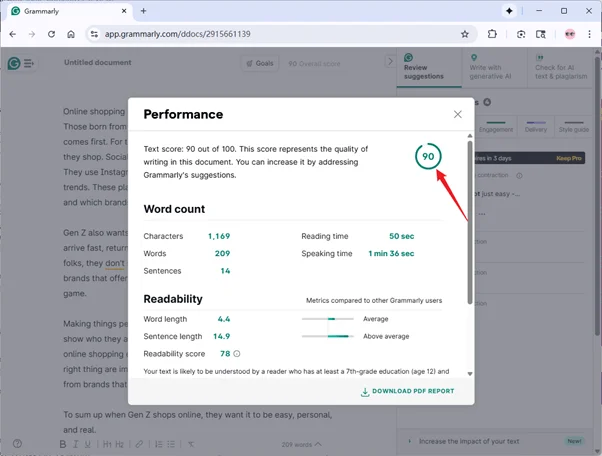
Accept Grammarly’s Suggestions
We then accepted Grammarly’s suggestions to improve the text. The grammar and readability score improved to 100/100. The minor issues found earlier were addressed, and the text now reads clearly, with a better flow.
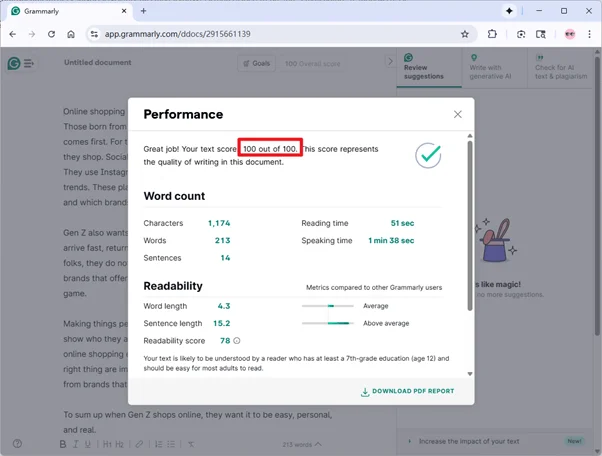
AI Detection Scores After Grammarly Improvements
After correcting the grammar, we ran the humanized text through the AI detection tools again. Here's how the AI scores changed:
Detector | AI Scores After Humanization | IA Scores After Grammarly Improvements |
|---|---|---|
QuillBot | 31% AI | 20% AI |
Originality.ai | 100% AI | 100% AI |
ZeroGPT | 79% AI | 70% AI |
GPTzero | 100% AI | 95% AI |
Writer | 6% AI | 5% AI |
The AI scores changed slightly after the revisions.
The biggest improvement was in tools like QuillBot and ZeroGPT, where the scores dropped, suggesting that the grammar fixes helped make the text sound more human-like.
However, with detectors like Originality.ai and GPTzero, the AI score remained mostly unchanged, indicating that these tools still flagged the content as mostly AI-generated.
This shows that while fixing grammar can enhance readability and make the text feel more natural, it doesn't always fool the more sensitive AI detectors, especially those that pick up on deeper patterns in the writing.
How User-Friendly Is Writesonic?
Writesonic AI Humanizer is pretty easy to use. The interface is clean and simple, making it quick to get started. However, the free version has a limit of 200 words per session, so you'll need to break up longer texts.
The tool lets you choose from various tones—engaging, bold, friendly, academic, persuasive, and more—so you can customize the style to fit your needs.
It also supports over twenty languages
In terms of speed, it's okay, though it’s not instant. You’ll need to wait a bit for the humanized text to process.
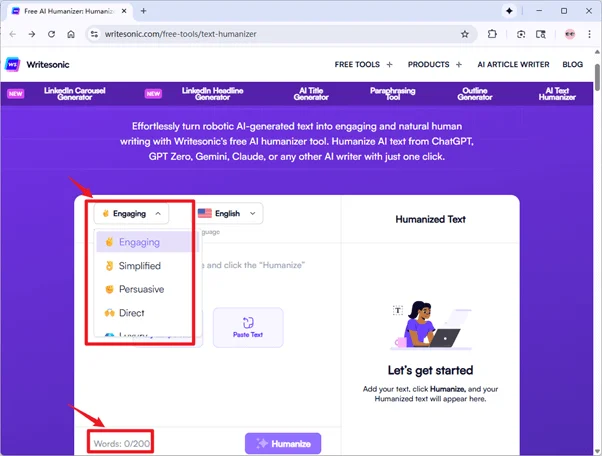
Pros and Cons of Writesonic
Pros
Clean and easy-to-use interface: The layout is simple enough. You can paste your text, pick a tone, and get results without extra steps.
Supports multiple languages: Handles over twenty languages, making it practical for users who work across different regions or need multilingual content.
Flexible for different content types: Whether it’s academic writing, blog posts, or social media captions, the tool can adjust to different writing contexts.
Cons
Limited word count per use: You can only humanize 200 words at a time, which means longer pieces have to be split and reprocessed multiple times.
Not the fastest tool: The results can take a short while to generate, especially during busy times or with larger text blocks.
The Best Alternative to Writesonic
Writesonic works fine for short pieces,but that 200-word limit can really slow you down, right?
If you’re dealing with longer text or just want something more flexible, you might want to give EssayDone a try instead.
What Is EssayDone?
Like Writesonic, EssayDone's Humanizer helps detect AI likelihood and humanizes text. It claims an impressive 80% success rate on the first try, making it a reliable tool for improving the natural flow of your content.
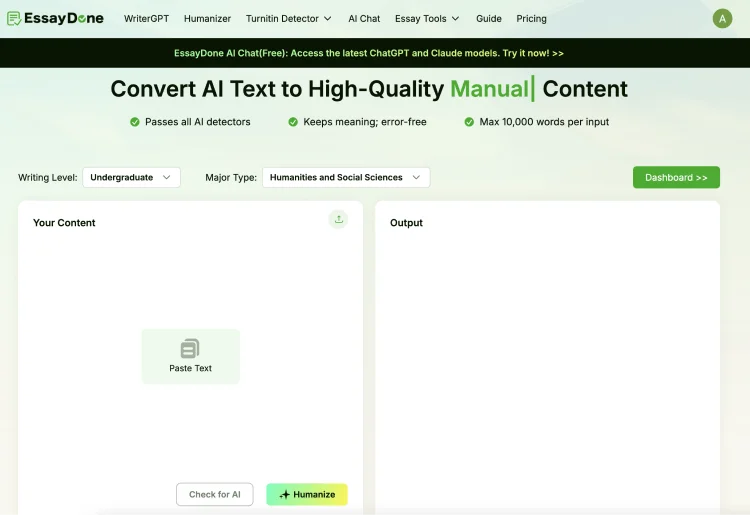
What Makes EssayDone a Strong Alternative?
Here’s why EssayDone stands out:
1000 Free Words: No credit card required, and you get 1000 free words to humanize.
20+ Models: Choose from over 20 writing purposes, including academic essays, application letters, and marketing copy—ideal for students, marketers, and businesses.
Fewer Grammatical Errors: EssayDone focuses on producing cleaner, higher-quality text with fewer grammar issues.
Turnitin Detector: Get a detailed AI report before submitting, ensuring your text is ready for scrutiny.
Summary
So, that’s our take on the Writesonic AI Humanizer. Sure, it can help tweak your text, but passing AI checks is only half the game—the content still needs to sound natural and solid.
If you want something with more freedom and a bigger word limit, EssayDone could be a better fit.
Anyway, you should only invest in an AI humanizer that truly beats detection while keeping your writing quality intact, right?
